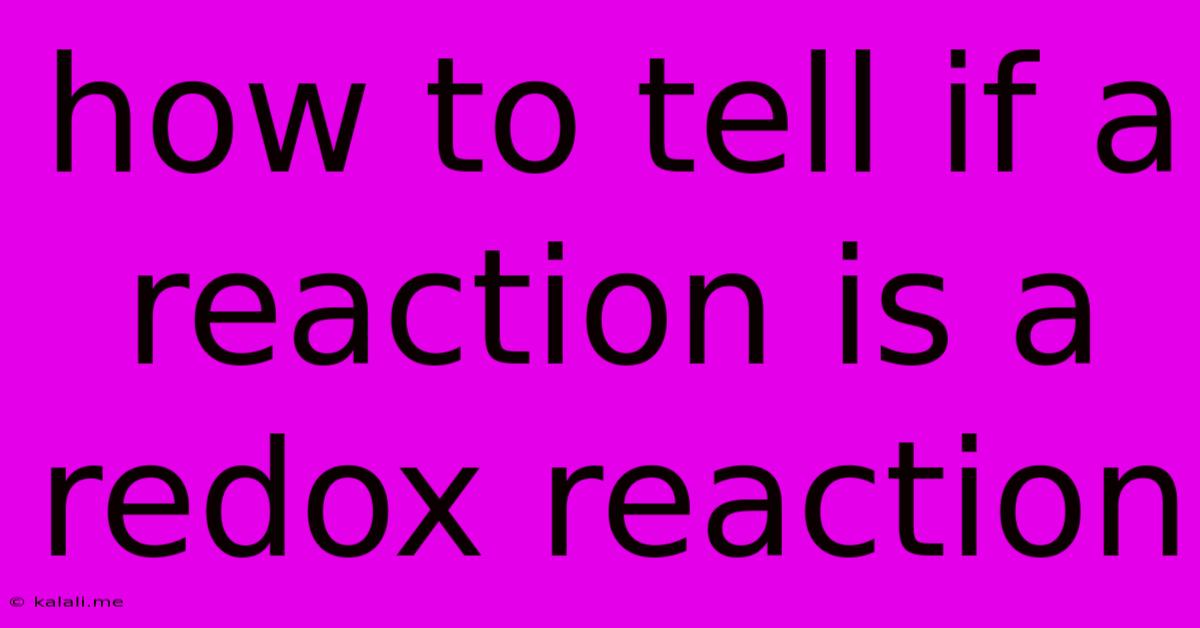How To Tell If A Reaction Is A Redox Reaction
Kalali
May 09, 2025 · 3 min read

Table of Contents
How to Tell if a Reaction is a Redox Reaction: A Comprehensive Guide
Meta Description: Learn how to identify redox reactions easily! This guide explains oxidation and reduction, provides practical tips for recognizing electron transfer, and offers examples to solidify your understanding. Master redox reactions with clear explanations and illustrative examples.
Redox reactions, short for reduction-oxidation reactions, are fundamental in chemistry and crucial for understanding many everyday processes, from rusting to respiration. But how do you actually tell if a reaction falls into this category? This comprehensive guide will equip you with the knowledge and tools to confidently identify redox reactions.
Understanding Oxidation and Reduction
The core principle behind redox reactions is the transfer of electrons between species. Two processes always occur simultaneously:
-
Oxidation: The loss of electrons by a species. The species that loses electrons is said to be oxidized. Remember the mnemonic OIL RIG – Oxidation Is Loss, Reduction Is Gain (of electrons).
-
Reduction: The gain of electrons by a species. The species that gains electrons is said to be reduced.
Therefore, a redox reaction involves one species being oxidized and another being reduced. It's a coupled process; one cannot happen without the other.
Key Indicators of Redox Reactions
Several clues can help you identify if a reaction is a redox reaction:
-
Changes in Oxidation States: This is the most reliable method. Assign oxidation numbers to each element in the reactants and products. If the oxidation number of an element increases (becomes more positive), it's been oxidized. If it decreases (becomes more negative), it's been reduced. A change in oxidation state for at least two elements signifies a redox reaction.
-
Presence of Oxidizing and Reducing Agents: An oxidizing agent is a substance that causes oxidation by accepting electrons and thus getting reduced itself. A reducing agent is a substance that causes reduction by donating electrons and thus getting oxidized itself. Identifying these agents often hints at a redox reaction. Common oxidizing agents include oxygen, chlorine, and permanganate ions. Common reducing agents include hydrogen, metals, and some organic compounds.
-
Electron Transfer (Explicitly Shown): Some reactions explicitly show electron transfer in their balanced equations. If you see electrons (e⁻) as a reactant or product, it's undoubtedly a redox reaction.
Practical Examples: Identifying Redox Reactions
Let's illustrate with some examples:
Example 1 (Redox Reaction):
2Mg(s) + O₂(g) → 2MgO(s)
- Magnesium (Mg) goes from an oxidation state of 0 to +2 (oxidation).
- Oxygen (O) goes from an oxidation state of 0 to -2 (reduction).
This is a redox reaction because magnesium is oxidized, and oxygen is reduced.
Example 2 (Not a Redox Reaction):
HCl(aq) + NaOH(aq) → NaCl(aq) + H₂O(l)
This is an acid-base neutralization reaction. There's no change in oxidation states for any of the elements involved. Hydrogen remains +1, chlorine remains -1, sodium remains +1, and oxygen remains -2.
Example 3 (Redox Reaction with explicit electron transfer):
Zn(s) + Cu²⁺(aq) → Zn²⁺(aq) + Cu(s)
This reaction clearly shows the transfer of two electrons from zinc to copper ions. Zinc is oxidized, and copper is reduced.
Beyond the Basics: More Complex Scenarios
Identifying redox reactions can become more challenging with complex organic reactions or reactions involving multiple elements undergoing changes in oxidation states. In such cases, meticulously assigning oxidation numbers and carefully tracking electron transfer become paramount.
Conclusion
Understanding how to identify redox reactions is crucial for a strong foundation in chemistry. By mastering the concepts of oxidation and reduction, recognizing changes in oxidation states, and identifying oxidizing and reducing agents, you can confidently analyze chemical reactions and determine their redox nature. Remember to practice with various examples to solidify your understanding and improve your ability to identify these important reactions.
Latest Posts
Latest Posts
-
127 Out Of 150 As A Percentage
May 09, 2025
-
How Does The Respiratory System Work With The Digestive
May 09, 2025
-
Is 41 A Prime Number Or A Composite Number
May 09, 2025
-
What Is 76 Of An Hour
May 09, 2025
-
How Long Is 55cm In Inches
May 09, 2025
Related Post
Thank you for visiting our website which covers about How To Tell If A Reaction Is A Redox Reaction . We hope the information provided has been useful to you. Feel free to contact us if you have any questions or need further assistance. See you next time and don't miss to bookmark.